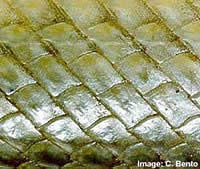scales
Scales are the small bony or horny plates that form the body covering of reptiles and fish.
 |
| Ganoid scales of the Florida gar
|
There are four main kinds of scales in fish, as described below.
Placoid
These are found in sharks and rays, and can vary greatly in appearance. They don't increase in size as the fish grows; instead new scales are added. Placoid scales consist of a flattened rectangular base plate which is embedded in the fish, and variously developed structures, such as spines, which project backwards on the surface.
Cosmoid
These are found in lungfish and some fossil fishes. Cosmoid scales are similar to placoid scales and probably evolved from the fusion of placoid scales. They consist of two basal layers of bone, a layer of dentine-like cosmine, and an outer layer of vitrodentine.
Ganoid
These are found in fishes such as the bichirs, bowfin, paddlefish, gars, and sturgeons. Ganoid scales are usually rhomboid in shape and have articulating peg and socket joints between them.
Cycloid and ctenoid
Cycloid and ctenoid scales are found in the majority of bony fishes. The anterior part of each scale is usually overlapped by the posterior portion of the scale in front. This arrangement of overlapping scales gives the fish greater flexibility than in those species with cosmoid and ganoid scales.
Unlike fish scales, reptile scales are not separate, detachable structures. Instead, they are connected in a sheet, which is the outermost layer of skin. Every so often, this layer of skin is shed and replaced. In some reptiles the skin flakes off in chunks. In snakes, the skin is usually shed in one piece. Reptilian scales are of two types: horny epidermal corneoscutes sometimes fused with underlying bony dermal osteoscutes.


